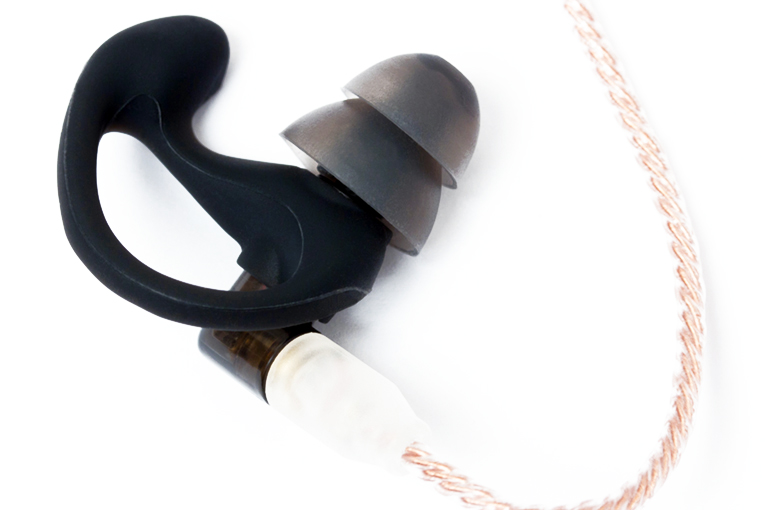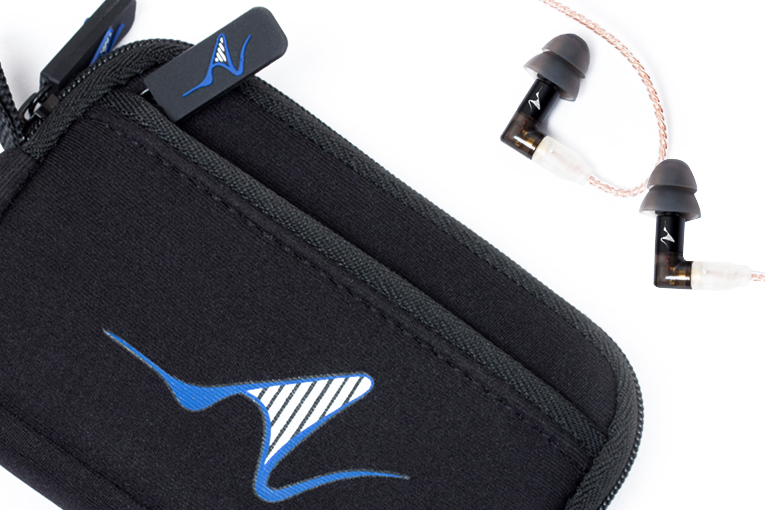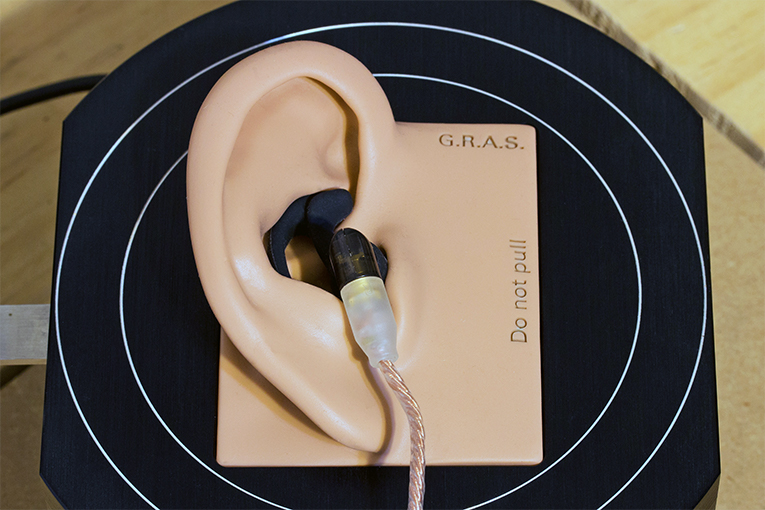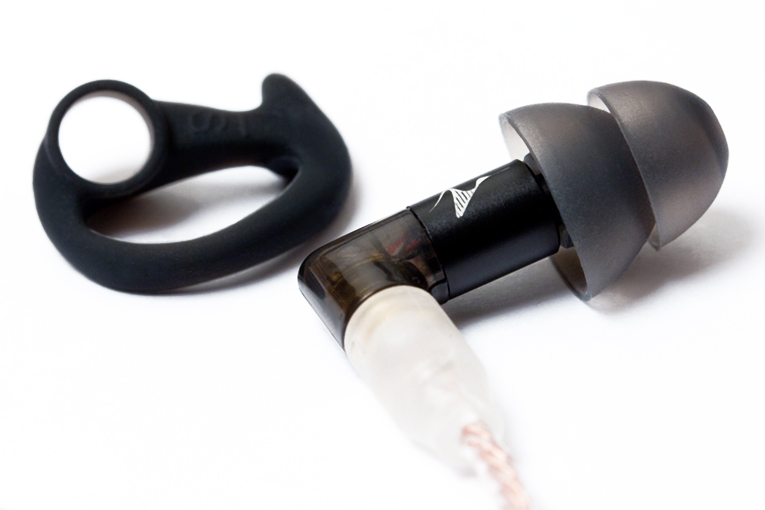Sound: 









Value: 









(Read about our ratings)
Measurements can be found by clicking this link.
It’s difficult for audio companies to differentiate themselves, because there are so many of them and most of the good ideas have already been done. That’s why I so admire companies that find a different approach. One of those is Akoustyx, a new company I first encountered at the 2018 Rocky Mountain Audio Fest, and the manufacturer of the R-220 earphones ($199.99 USD) reviewed here. Instead of spinning stories of some specious sonic “secret sauce,” Akoustyx focuses on making sure its earphones fit properly in your ears and stay in place once you get them in.
The R-220s come with special rubber flanges developed by a company called Surefire, which sells a line of hearing-protection products intended primarily for shooters. These products feature a skeletal rubber retention flange that holds the earplug in place, using what the company says are seven contact points within the ear. Akoustyx had a version of this flange made for its earphones. The flange is supplied in three sizes, and slips onto the R-220s’ tube-shaped earpieces. This attention to fit is the norm in sports earphones designed for joggers, but rarely do we see it in earphones intended for audiophiles.

And the R-220s are definitely intended for audiophiles. Each of the R-220s’ earpieces packs two Knowles balanced armatures, a driver type known especially for its extended and detailed treble response. Surrounding the armatures is a housing made from anodized aluminum, attached to a polycarbonate housing for an industry-standard MMCX connector. With this connector, you can replace the cables if they get damaged, or try some aftermarket cables in pursuit of a different sound or look. Attached to the cable for the left earpiece is an inline remote with volume, play/pause, and track-skip controls, and an integral microphone. Audiophiles who prefer to buy American will love the fact that Akoustyx assembles its earphones in Nashville, Tennessee.
In the box
The R-220s include single-flange silicone tips in three sizes, a set of double-flange silicone tips, and one set of Comply T-100 foam tips. As noted above, the retention flanges are supplied in three sizes. The Kevlar-reinforced cable measures 4.2' (1.3m), and is tipped with a 1/8" (3.5mm) plug. A zippered neoprene case is supplied; it has a second zippered pouch to hold extra eartips and flanges.

Use
As with any earphones that use retention flanges, figuring out how to properly assemble the R-220s and fit them into your ears is a little challenging. Not only do you have to find the eartip that fits you best, but you also have to find the retention flange that fits you best. However, Akoustyx does provide a little manual with diagrams that explain the process. One nice twist with the R-220s is that the retention flanges can be flipped around either way, allowing for conventional or over-ear cable routing -- whichever you prefer.
Once the R-220s are properly set up for your ears, the fit and comfort are outstanding. The super-lightweight earpieces, combined with the retention flanges and a narrow design that fits easily into the ear canal, create a set of earphones that go in easily and fit comfortably. They produce an excellent, effortless seal in the ear canal, and they stay put even when you shake your head back and forth. They’re so comfortable that I've started using them as hearing protectors when I play 85dB pink noise for my isolation measurements.

Somewhat contrary to what I found in my measurements, the R-220 didn’t prove challenging for any of my source devices to drive. Even my Samsung Galaxy S9 smartphone sounded fine with the R-220s -- and in at least one case I’ll discuss below, the phone gave me a better sound than the standalone DAC-amps.
Sound
The sonic character of the R-220s will be familiar and welcome to fans of Etymotic earphones and Grado headphones. As with these products, most of the focus with the R-220s is on the mids and treble, which are clear and largely uncolored. There is some bass -- and it’s precise, well-defined bass -- but it’s low in level relative to the rest of the sonic spectrum. I hear live music many times per month, and the performances I hear (including jazz, classical, pop, and rock) have a fuller sound than these products deliver. But many people like the thinner, less-bassy sound; you’ll encounter passionate Etymotic fans commenting on headphone websites and posting in audio forums.
Led Zeppelin’s classic “Houses of the Holy,” from the album Physical Graffiti (16-bit/44.1kHz WAV, Atlantic/Spotify), provides an easy way to describe what the R-220s sound like. In the treble and mids, the R-220s’ response sounded largely uncolored, with no readily apparent dips or peaks. Sonic details really pop out at you with these earphones. You can hear every little subtlety (or unsubtlety) in John Bonham’s snare drum and cymbal work, in Jimmy Page’s layered guitars, and in Robert Plant’s voice. But you lose much of the propulsive force of John Paul Jones’s electric bass line. It’s kind of like a cake with a whole lot of icing and not that much cake. But for a lot of people, the icing is by far the best part of the cake, and sometimes they eat all the icing and leave most of the cake.
Although Casey Abrams’s double bass playing is a big part of his album Put a Spell on You (24/96 AIFF, Chesky), the bass is miked at a distance, so it’s not a bass-heavy album at all. Here, the R-220s’ attenuated bass output isn’t much of an issue. In “Have You Ever Seen the Rain,” Abrams’s voice sounded super clear, if a little bit bright, and the acoustic guitar that appears to his right sounded lively and precisely imaged, although there wasn’t as much power from the guitar’s low E and A strings as I heard through the earphones I used for comparison. The R-220s highlighted the percussive effects of Abrams’s appropriately aggressive playing, such as the slap of the strings against the fingerboard. Audiophiles who go crazy for percussively played double bass will love the way the R-220s bring this out, but listeners who prefer a fuller sound won’t like it as much.

Using the R-220s to check out the latest hip-hop recordings, such as Juice WRLD’s “Armed and Dangerous” (single, 320kbps Ogg Vorbis, Interscope / Grade A Productions / Spotify), might seem unfair, but how do I know what kind of music our readers might listen to through these earphones? Actually, though, the R-220s handled this bass-dominant track well, with clean, undistorted deep bass hits. But once again, the focus was on the mids and treble, which made Juice WRLD’s rap, the accompanying vocals, and the electronic effects sound especially loud and clear. That’s not to say hip-hop fans will like this tonal balance; even though the R-220s had the extension needed to reproduce the bass notes in “Armed and Dangerous,” they reproduced these tones at a relatively low level, so it sounded as if the bass control on a stereo had been turned down about 6dB.
On the above cuts, I could see how someone might prefer the R-220s’ treble-heavy sound to a more balanced response. On some tunes, though, I found the tonal balance tilt more distracting. For example, in Diana Krall’s take on “Fly Me to the Moon” from Live in Paris (320kbps Ogg Vorbis, Verve), the snare drum and Krall’s voice sounded rather sizzly, and the bass was barely there.
I’d been going back and forth between two DAC-amps: an Audioengine D3 and an iFi xDSD. Out of curiosity, I plugged the R-220s into my Samsung Galaxy S9 smartphone, expecting them to sound even brighter, but they actually sounded a little more balanced overall on the Diana Krall track, with a subtly softer treble that subjectively elevated the bass response ever so slightly. But still, there wasn’t much bass.
Comparison
I and my listening panel compared the R-220s mostly to two other earphones in the same price range: the Campfire Comets ($199) and the 1More Quad Drivers ($199.99). The Comets use a single balanced armature per earpiece, and the Quad Drivers team one dynamic driver with three balanced armatures.
These three earphones propose substantially different ideas about what music should sound like. In general, the Quad Drivers offered the fullest and, arguably, most natural tonal balance, but lacked some of the treble and midrange clarity and smoothness of the Comets and R-220s. The Comets had a slightly bass-shy, subtly midrange-focused performance with unusual clarity for the price. The R-220s tilted the balance the furthest to the treble -- and the furthest from the bass.

A great example can be found in the fourth movement, “IV. Allegro Frenetico (Orgy of Brigands. Memories of Scenes Past),” of Berlioz’s Harold in Italy, Op.16 by the San Diego Symphony Orchestra conducted by Yoav Talmi, with violist Rivka Golani and violinist Igor Gruppman (16/44.1 WAV, Naxos). True to its name, this movement features frantic work by the orchestra’s string section, and ends with a heavy show of support from the horns. On this selection, the Comets sounded just a little light, slightly hyping the violins and violas, and not quite delivering all of the literal “oomph” of the horns. The R-220s lost more of the body in the horns; it seems like they pulled me right up to point-blank range of the string section, but pushed the horn section 20' further back on the stage. Good if you love strings! The Quad Drivers did the worst on the strings -- they seemed to introduce a bit of cupped-hands coloration in the upper mids, so the string section didn’t sound as open, but they’re the only one of the three that delivered the horns with a realistic sense of power.
For both of my outside panelists -- John Higgins, who holds a masters in music performance from USC and has served as a frequent contributor to Wirecutter and Sound & Vision, and LeRena Major, a Los Angeles-based saxophonist who’s held several positions in the music business and is a voting member of the National Academy of Recording Arts & Sciences -- the design of the R-220s was appealing but the tonal balance was not. Both felt the treble was overemphasized to the point of being uncomfortable in some passages. But LeRena thought the R-220s would make a nice set of what she referred to as “workaday” earphones, largely because of the comfort and the security of the fit.
Conclusion
Almost every day in my work as a reviewer, I recall one of my favorite quotes: “To the extent that individual preferences in sound -- digital, analog, or live -- arise from a listener’s personal idiosyncrasies, one can hardly take issue with anyone else’s beliefs about sound quality.”

If you’ve been daring enough to venture a guess as to who said that, I commend you -- but I’m sad to report that you’re wrong. The quotee was Julian Hirsch, the legendary and largely reviled technical editor of Stereo Review magazine. Audiophiles tend to think of Hirsch as completely intolerant of audio subjectivism, but this quote suggests his work is more fair-minded than many assume.
Hirsch’s quote suits the Akoustyx R-220s. They’re a well-made set of earphones that fit wonderfully and have a treble-heavy, bass-shy balance. Research and experience show that this kind of response won’t suit the taste of most listeners, but some people -- e.g., current fans of Etymotic earphones -- will likely love it. If that’s you, you should check these out.
. . . Brent Butterworth
Associated Equipment
- DAC-headphone amps -- iFi xDSD, Audioengine D3
- Source -- Samsung Galaxy S9 smartphone
Akoustyx R-220 Earphones
Price: $199.99 USD.
Warranty: One year repair, replacement, or refund
Akoustyx
Website: www.akoustyx.com





